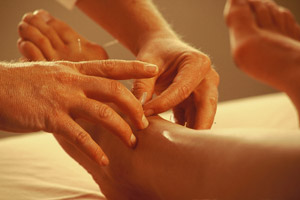
Breast pain associated with lactation
 Beginning in 2004, the practitioners of Meridian Health Solutions (MHS) have been working in conjunction with the lactation consultants at UNC-Chapel Hill to study the use of acupuncture in treating breast pain associated with lactation. For the purpose of this study, all patients referred to MHS have received western or conventional-medicine treatment for a minimum of one month without positive results. Given that the lactation consultants at UNC are among the best in the region, these referrals are generally considered to be the most recalcitrant and difficult-to-treat cases.
Beginning in 2004, the practitioners of Meridian Health Solutions (MHS) have been working in conjunction with the lactation consultants at UNC-Chapel Hill to study the use of acupuncture in treating breast pain associated with lactation. For the purpose of this study, all patients referred to MHS have received western or conventional-medicine treatment for a minimum of one month without positive results. Given that the lactation consultants at UNC are among the best in the region, these referrals are generally considered to be the most recalcitrant and difficult-to-treat cases.
Our in-house data show that we're able to help reduce lactation pain in the majority of the cases we see, with most patients experiencing immediate pain reduction during the first treatment. Patients are properly draped during these treatments with no needles ever inserted into their breasts, making this a safe and comfortable treatment process. We give patients acupressure points they can stimulate at home either with massage or heat, which is easy to do, lengthens the benefits of the treatments, and reduces the number of treatments they require.
As clinicians who care deeply about the health of new mothers and babies, we are so glad to provide treatments that quickly, safely, and effectively reduce lactation pain, since healthy breastfeeding is so important for the short and long term health of the mother and baby. As a result of ongoing benefits to the patients, we're still getting regular referrals from the UNC-Chapel Hill lactation consultants almost 20 years after initiating the study!
Traditional East Asian Medicine Treatment Strategies
One of Traditional East Asian medicine’s foundational principles emphasizes that every individual is unique. That is, even if two people present with similar complaints, the cause of illness for one person almost certainly differs from that of the other. Therefore every person’s course of treatment must be individually-tailored to suit their particular need, including when treating lactation pain.
Acupuncture is the insertion of sterile, thin needles into specific sites on the body. Pain is usually caused by what Chinese medicine calls “stagnation,” therefore, the treatment is aimed toward inserting needles at sites that would open the energy channels and remove energy stagnation. When treating lactation-associated breast pain, acupuncture opens the corresponding channels, thereby reducing the pain. Often, the pain reduction/elimination is immediate upon insertion of the appropriate needles.
Chinese Herbal Medicine (CHM) is a science and art supported by at least 2,000 years of empirical practice. Medical practitioners have prescribed herbs for post-partum complaints for centuries. This form of therapy can be useful for lactating women as well, with unique herbal formulas recommended for specific conditions.
Nutrition is an essential component of good general health, and is an especially important aspect for those with plugged ducts associated with lactation. Understanding a mother’s and her baby’s dietary and nutritional needs provides the framework for implementing specific, effective dietary changes. The suggested changes usually involve introducing nutritious and delicious foods into the diet. Often, simple dietary changes make a profound difference within one week.
Western Medicine’s Approach
Western medicine can offer antibiotic or antifungal medications in cases of bacterial and fungal infections in a lactating woman. These medications can be oral or topical. However, a common conundrum is that when a woman has a bacterial infection, the antibiotics that treat the infection often are the cause for a consequent fungal infection. In the absence of identifiable infection, lactation consultants will work with a nursing mother to identify possible causes of lactation pain, such as vasospasm of the areola, improper breastfeeding positioning, or poor latch-on by the infant. Remedies for these conditions may include warm compresses, dietary supplements, and correcting the infant's latch.
What Can I Expect During a Session?
During the initial visit we discuss your medical history, your baby’s nursing history, take a careful look at your dietary habits, and perform a physical examination. The physical examination consists of checking the pulse on your wrists, looking at the tongue and performing diagnostic palpations around the abdomen and neck. We may ask you to find the most painful area on your breast(s) yourself while we palpate other areas on your body with the intention of releasing the pain in your breasts. The palpations offer further insights into the exact nature of your situation. The breast itself is never needled. The overall treatment plan typically consists of some combination of acupuncture, acupressure homework, custom-tailored herbal medicine, nutritional changes, and stress reduction techniques.
References
1. Lao L. et al. Is Acupuncture Safe? A Systematic Review of Case Reports. Altern Ther Health Med 2003;9(1):72-83
2. Neri I, et al. Acupuncture treatment as breastfeeding support: preliminary data. J Altern Complement Med 2011 Feb;17(2):133-7. Epub 2011 Feb 8.
3. KvistLJ, et al. A randomised-controlled trial in Sweden of acupuncture and care interventions for the relief of inflammatory symptoms of the breast during lactation. Midwifery. 2007 Jun;23(2):184-95. Epub 2006 Oct 18.


